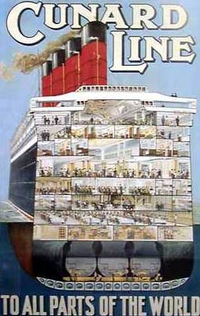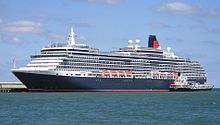- Cunard Line
-
- Cunard redirects here. For other uses, see Cunard (disambiguation).
Cunard Line 
Type Subsidiary of Carnival Corporation & plc Founded 1840, as the British and North American Royal Mail Steam Packet Company Headquarters Southampton, United Kingdom, and Santa Clarita, California, United States Area served Transatlantic, Mediterranean, Northern Europe, Caribbean and World Cruises. Key people Samuel Cunard (Founder)
Peter Shanks (President)Parent Carnival Corporation & PLC Website Cunard.com Cunard Line is a British-American owned shipping company based at Carnival House in Southampton, England and operated by Carnival UK. It has been a leading operator of passenger ships on the North Atlantic for over a century. In 1839, Canadian-born Samuel Cunard was awarded the first British transatlantic steamship mail contract, and the next year formed the British and North American Royal Mail Steam-Packet Company to operate the line's four pioneer paddle steamers on the Liverpool–Halifax–Boston route. For most of the next 30 years, Cunard held the Blue Riband for the fastest Atlantic voyage. However, in the 1870s Cunard fell behind its rivals, the White Star Line and the Inman Line. To meet this competition, in 1879 the firm was reorganized as Cunard Steamship Company, Ltd to raise capital.[1]
In 1902, White Star joined the American owned International Mercantile Marine Co. and the British Government provided Cunard with substantial loans and a subsidy to build two superliners needed to retain its competitive position. Mauretania held the Blue Riband from 1909 to 1929. The sinking of her sister ship Lusitania in 1915 was one of the causes of the United States' entering the First World War. In the late 1920s, Cunard faced new competition when the Germans, Italians and French built large prestige liners. Cunard was forced to suspend construction on its own new superliner because of the Great Depression. In 1934 the British Government offered Cunard loans to finish the Queen Mary and to build a second ship, the Queen Elizabeth, on the condition that Cunard merged with the then ailing White Star line to form Cunard White-Star Ltd. Cunard owned two-thirds of the new company. Cunard purchased White Star's share in 1947; the name reverted to the Cunard Line in 1950.[1]
Winston Churchill estimated that the two Queens helped to shorten the Second World War by at least a year. Upon the end of the war, Cunard regained its position as the largest Atlantic passenger line. By the mid 1950s, it operated twelve ships to the United States and Canada. After 1958, transatlantic passenger ships became increasingly unprofitable because of the introduction of jet airliners. Cunard withdrew from its year round service in 1968 to concentrate on cruising and summer transatlantic voyages for vacationers. The Queens were replaced by the Queen Elizabeth 2 (QE2), which was designed for the dual role.[2] In 1998 Cunard was acquired by the Carnival Corporation and five years later QE2 was replaced on the Transatlantic runs by the Queen Mary 2 (QM2). The line also operates the Queen Victoria (QV) and the Queen Elizabeth (QE). At the moment, Cunard is the only shipping company to operate a scheduled passenger service between Europe and North America.
Contents
History
1840–65
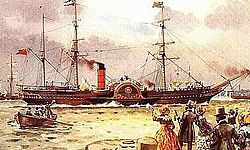 Britannia of 1840 (1150 GRT), the first Cunard liner built for the transatlantic service.
Britannia of 1840 (1150 GRT), the first Cunard liner built for the transatlantic service.
The British Government started operating monthly mail brigs from Falmouth, England to New York in 1756. These ships carried few non-governmental passengers and no cargo. In 1818, the Black Ball Line opened a regularly scheduled New York–Liverpool service with clipper ships, beginning an era when American sailing packets dominated the North Atlantic saloon-passenger trade that lasted until the introduction of steamships.[1] A Committee of Parliament decided in 1836 that to become more competitive, the mail packets operated by the Post Office should be replaced by private shipping companies. The Admiralty assumed responsibility for managing the contracts.[3] Famed Arctic explorer, Admiral Sir William Edward Parry was appointed as Comptroller of Steam Machinery and Packet Service in April 1837.[4] Nova Scotians led by their young Assembly Speaker, Joseph Howe lobbied for steam service to Halifax. On his arrival in London in May 1838, Howe discussed the enterprise with fellow Nova Scotian Samuel Cunard (1787–1865), a shipowner who was also visiting London on business.[5] Cunard and Howe were associates and Howe also owed Cunard £300.[6] (£21,724 as of 2011),[7] Cunard returned to Halifax to raise capital, and Howe continued to lobby the British government.[5] The Rebellions of 1837 were ongoing and London realized that the proposed Halifax service was also important for the military.[8]
That November, Parry released a tender for North Atlantic monthly mail service to Halifax beginning in April 1839 using steamships with 300 horsepower.[8] The Great Western Steamship Company, which had opened its pioneer Bristol–New York service earlier that year, bid £45,000 for a monthly Bristol–Halifax–New York service using three ships of 450 horsepower. While British American, the other pioneer transatlantic steamship company did not submit a tender,[9] the St. George Steam Packet Company, owner of the Sirius, bid £45,000 for a monthly Cork-Halifax service[10] and £65,000 for a monthly Cork–Halifax–New York service. The Admiralty rejected both tenders because neither bid offered to begin services early enough.[11]
Cunard, who was back in Halifax, did not know of the tender until after the deadline.[9] He returned to London and started negotiations with Admiral Parry, who was Cunard's good friend from when Parry was a young officer stationed in Halifax 20 years earlier. Cunard offered Parry a fortnightly service beginning in May 1840. While Cunard did not then own a steamship, he had been an investor in an earlier steamship venture, the Royal William, and owned coal mines in Nova Scotia.[5] Cunard's major backer was Robert Napier, who was the Royal Navy's supplier of steam engines.[9] He also had the strong backing of Nova Scotian political leaders at the time when London needed to rebuild support in British North America after the rebellion.[8]
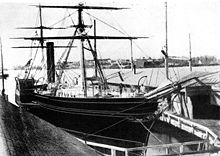 Europa of 1848 (1850 GRT). This is one of the earliest known photos of an Atlantic steamship.
Europa of 1848 (1850 GRT). This is one of the earliest known photos of an Atlantic steamship.
Over Great Western's protests,[12] in May 1839 Parry accepted Cunard's tender of £55,000 for a three-ship Liverpool–Halifax service with an extension to Boston and a supplementary service to Montreal.[5] The annual subsidy was later raised £81,000 to add a fourth ship[13] and departures from Liverpool were to be monthly during the winter and fortnightly for the rest of the year.[1] Parliament investigated Great Western's complaints, and upheld the Admiralty's decision.[11] Napier and Cunard recruited other investors including businessmen James Donaldson, Sir George Burns, and David MacIver. In May 1840, just before the first ship was ready, they formed the British and North American Royal Mail Steam Packet Company with initial capital of £270,000, later increased to £300,000.(£21,239,138 as of 2011),[7] Cunard supplied £55,000.[5] Burns supervised ship construction, McIver was responsible for day to day operations, and Cunard was the "first among equals' in the management structure. When MacIver died in 1845, his younger brother Charles assumed his responsibilities for the next 35 years.[9] (For more detail of the first investors in the Cunard Line and also the early life of Charles Maciver, see Liverpool Nautical Research Society's Second Merseyside Maritime History pp 33–37 1991)
In May 1840 the coastal paddle steamer Unicorn made the company's first voyage to Halifax [14] to begin the supplementary service to Montreal. Two months later the first of the four ocean-going steamers of the Britannia Class, departed Liverpool, arriving in Halifax after 12 days and 10 hours, averaging 8.5 knots (15.7 km/h), before proceeding to Boston. During 1840–41, mean Liverpool–Halifax times for the quartet were 13 days 6 hours to Halifax and 11 days 4 hours homeward. Two larger ships were quickly ordered, one to replace the Columbia, which sank at Seal Island, Nova Scotia in 1843 without loss of life. By 1845, steamship lines led by Cunard carried more saloon passengers than the sailing packets.[1] Three years later, the British Government increased the annual subsidy to £156,000 so that Cunard could double its frequency.[13] Four additional wooden paddlers were ordered and alternate sailings were direct to New York instead of the Halifax-Boston route. The sailing packet lines were now reduced to the immigrant trade.[1]
From the beginning Cunard's ships used the line's distinctive red funnel with two or three narrow black bands and black top. It appears that Robert Napier was responsible for this feature. His shipyard in Glasgow used this combination previously in 1830 on Thomas Assheton Smith's private steam yacht "Menai". The renovation of her model by Glasgow Museum of Transport revealed that she had vermilion funnels with black bands and black top.[15]
Cunard's reputation for safety was one of the significant factors in the firm's early success.[2] Both the first two transatlantic lines failed after major accidents. British and American collapsed after the President foundered in a gale and Great Western after Great Britain stranded because of a navigation error.[1] Cunard's orders to his masters were, "Your ship is loaded, take her; speed is nothing, follow your own road, deliver her safe, bring her back safe - safety is all that is required."[2] In particular, it was Charles MacIver's constant inspections that was responsible for the firm's safety discipline.[9]
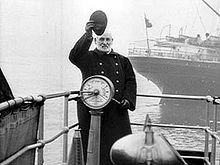 A captain waves aboard a Cunard Line vessel.
A captain waves aboard a Cunard Line vessel.
In 1850 the American Collins Line and the British Inman Line started new Atlantic steamship services. The American Government supplied Collins with a large annual subsidy to operate four wooden paddlers that were superior to Cunard's best.[13] Inman showed that iron-hulled screw propelled steamers of modest speed could be profitable without subsidy. Inman also became the first steamship line to carry steerage passengers. Both of the newcomers suffered major disasters in 1854.[1] The next year, Cunard put pressure on Collins by commissioning its first iron-hulled paddler, the Persia, which won the Blue Riband with a Liverpool–New York voyage of 9 days 16 hours, averaging 13.11 knots (24.28 km/h).[16]
During the Crimean War Cunard supplied 11 ships for war service. Every British North Atlantic route was suspended until 1856 except Cunard's Liverpool-Halifax-Boston service. While Collins' fortunes improved because of the lack of competition during the war, it collapsed in 1858 after the loss of two additional steamers. Cunard emerged as the leading carrier of saloon passengers and in 1862 commissioned the Scotia, the last paddle steamer to win the Blue Riband. Inman carried more passengers because of its success in the immigrant trade. To compete, in May 1863 Cunard started a secondary Liverpool-New York service with iron-hulled screw steamers that catered for steerage passengers. Beginning with the China, the line also replaced the last three wooden paddlers on the New York mail service with iron screw steamers that only carried saloon passengers.[1]
1865–97
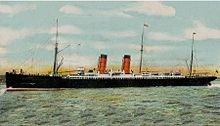 Etruria of 1885 (7,700 GRT)
Etruria of 1885 (7,700 GRT)
When Cunard died in 1865, the equally conservative Charles MacIver assumed Cunard's role.[9] The firm retained its reluctance about change and was overtaken by competitors that more quickly adopted new technology.[13] In 1866 Inman started to build screw propelled express liners that matched Cunard's premier unit, the Scota. Cunard responded with its first high speed screw propellered steamer, the Russia which was followed by two larger editions. In 1871 both companies faced a new rival when the White Star Line commissioned the Oceanic and her five sisters. The new White Star record-breakers were especially economical because of their use of compound engines. White Star also set new standards for comfort by placing the dining saloon midships and doubling the size of cabins. Inman rebuilt its express fleet to the new standard, but Cunard lagged behind both of its rivals. Throughout the 1870s Cunard passage times were longer than either White Star or Inman.[1]
In 1867 responsibility for mail contracts was transferred back to the Post Office and opened for bid. Cunard, Inman and the German Norddeutscher Lloyd were each awarded one of the three weekly New York mail services. The fortnightly route to Halifax formerly held by Cunard went to Inman. Cunard continued to receive a £80,000 subsidy (£5,165,840 as of 2011),[7] while NDL and Inman were paid sea postage. Two years later the service was rebid and Cunard was awarded a seven-year contract for two weekly New York mail services at £70,000 per annum. Inman was awarded a seven-year contract for the third weekly New York service at £35,000 per year.[11]
 Campania of 1893, (12,900 GRT)
Campania of 1893, (12,900 GRT)
The Panic of 1873 started a five-year shipping depression that strained the finances of all of the Atlantic competitors.[1] In 1876 the mail contracts expired and the Post Office ended both Cunard's and Inman's subsidies. The new contracts were paid on the basis of weight, at a rate substantially higher than paid by the United States Post Office.[11] Cunard's weekly New York mail sailings were reduced to one and White Star was awarded the third mail sailing. Every Tuesday, Thursday and Saturday a liner from one of the three firms departed Liverpool with the mail for New York.[17]
To raise additional capital, in 1879 the privately-held British and North American Royal Mail Steam Packet Company was reorganized as a public stock corporation, the Cunard Steamship Company, Ltd.[1] Under Cunard's new chairman, John Burns (1839–1900), son of one of the firm's original founders,[9] Cunard commissioned four steel-hulled express liners beginning with Servia of 1881, the first passenger liner with electric lighting throughout. In 1884, Cunard purchased the almost new Blue Riband winner Oregon from the Guion Line when that firm defaulted on payments to the shipyard. That year, Cunard also commissioned the record-breakers Umbria and Etruria capable of 19.5 knots (36.1 km/h). Starting in 1887, Cunard's newly won leadership on the North Atlantic was threatened when Inman and then White Star responded with twin propellered record-breakers. In 1893 Cunard countered with two even faster Blue Riband winners, the Campania and the Lucania, capable of 21.8 knots (40.4 km/h).[13]
1897–1929
 Crest of the 1921 Cunard liner Laconia
Crest of the 1921 Cunard liner Laconia
No sooner had Cunard re-established its supremacy than new rivals emerged. Beginning in the late 1860s several German firms commissioned liners that were almost as fast as the British mail steamers from Liverpool.[1] In 1897 Kaiser Wilhelm der Große of Norddeutscher Lloyd raised the Blue Riband to 22.3 knots (41.3 km/h), and was followed by a succession of German record-breakers.[16] Rather than match the new German speedsters, White Star commissioned four very profitable Celtic-class liners of more moderate speed for its secondary Livepool-New York service. In 1902 White Star joined the well-capitalized American combine, the International Mercantile Marine Co. (IMM), which owned the American Line, including the old Inman Line, and other lines. IMM also had trade agreements with Hamburg–America and Norddeutscher Lloyd.[1]
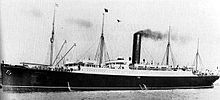 RMS Carpathia of 1901 (13,555 GRT) became famous for rescuing the survivors of the sinking of the RMS Titanic.
RMS Carpathia of 1901 (13,555 GRT) became famous for rescuing the survivors of the sinking of the RMS Titanic.
This was the Dreadnought era and British prestige was at stake. The British Government provided Cunard with an annual subsidy of £150,000 plus a low interest loan of £2.5 million (£199 million as of 2011),[7] to pay for the construction of the two superliners, the Blue Riband winners Lusitania and Mauretania, capable of 26.0 knots (48.2 km/h). In 1904 the firm started a Fiume–New York service with calls at Italian ports and Gibraltar. The next year Cunard commissioned two ships to compete directly with the Celtic-class liners on the secondary Liverpool-New York route. In 1911 Cunard entered the St Lawrence trade by purchasing the Thompson line, and absorbed the Royal line five years later.[1]
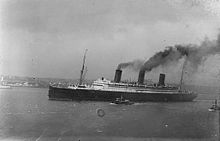 Berengaria of 1913 (51,950 GRT), originally Hapag's Imperator, was acquired by Cunard in 1921 to join Mauretania and Aquitania in the three-ship express service.
Berengaria of 1913 (51,950 GRT), originally Hapag's Imperator, was acquired by Cunard in 1921 to join Mauretania and Aquitania in the three-ship express service.
Not to be outdone, both White Star and Hamburg–America each ordered a trio of superliners. The White Star Olympic-class liners at 21.5 knots (39.8 km/h) and the Hapag Imperator-class liners at 22.5 knots (41.7 km/h) were larger and more luxurious than the Cunarders, but not as fast. Cunard also ordered a new ship, the Aquitania, capable of 24.0 knots (44.4 km/h), to complete the Liverpool mail fleet. Events prevented the expected competition between the three sets of superliners. White Star's Titanic sank on its maiden voyage, both White Star's Britannic and Cunard's Lusitania were war losses, and the three Hapag super-liners were handed over to the Allied powers as war reparations.[2]
In 1917 Cunard Line completed its European headquarters in Liverpool. The grand neo-Classical Cunard Building was the third of Liverpool's Three Graces. The headquarters were used by Cunard until the 1960s.[18]
Due to First World War losses, Cunard began a post-war rebuilding programme included eleven intermediate liners; Southampton replaced Liverpool as the British destination for the three-ship express service; and Cunard acquired the former Hapag Imperator (renamed the Berengaria) to replace the lost Lusitania as the running mate for Mauretania and Aquitania. By 1926 Cunard's fleet was larger than before the war, and White Star was in decline, having been sold by IMM.[1]
1929–71
Aquitania of 1914 (45,650 GRT).
Despite the dramatic reduction in North Atlantic passengers caused by the shipping depression beginning in 1929, the Germans, Italians and the French commissioned new "ships of state" prestige liners.[1] The German Bremen took the Blue Riband at 27.8 knots (51.5 km/h) in 1933, the Italian Rex recorded 28.9 knots (53.5 km/h) on a westbound voyage the same year, and the French Normandie crossed the Atlantic in just under four days at 30.58 knots (56.63 km/h) in 1937.[16] In 1930 Cunard ordered a 80,000 ton liner that was to be the first of two record-breakers fast enough to fit into a two-ship weekly Southampton-New York service. Work on hull 534 was halted in 1931 because of the economic conditions.[2]
By 1934 the White Star Line was failing and the British Government was concerned about potential job losses. David Kirkwood, MP for Clydebank where the unfinished hull 534 had been sitting idle for two and a half years, made a passionate plea in the House of Commons for funding to finish the ship and restart the dormant British economy.[19] The government offered Cunard a loan of £3 million to complete hull 534 and an additional £5 million to build the second ship, if Cunard merged with White Star.[2] The merger was accomplished by forming a new company, Cunard White Star, Ltd with Cunard owning about two-thirds of the capital.[1]
Due to the surplus tonnage of the new combined Cunard White Star fleet many of the older liners were sent to the scrapyard, these included the Mauretania and the ex-White Star liners Olympic and Homeric. In 1936, the ex-White Star Majestic was sold when hull 534, now named Queen Mary, replaced her in the express mail service.[2] Queen Mary reached 30.99 knots (57.39 km/h) on her 1938 Blue Riband voyage.[16] Cunard started construction on the Queen Elizabeth, and a smaller ship, the second Mauretania, joined the fleet and which also could be used on the Atlantic run when one of the Queens was in drydock for overhaul.[1] Berengaria was sold for scrap in 1938 after a series of fires.[2]
 Queen Mary of 1936 (80,700 GRT) in retirement at Long Beach, California as a floating museum/hotel ship.
Queen Mary of 1936 (80,700 GRT) in retirement at Long Beach, California as a floating museum/hotel ship.
During 1939–45 the Queens carried over two million servicemen and were credited by Churchill as helping to shorten the war by a year.[2] All four of the large Cunard express liners, the two Queens, Aquitania and Mauretania survived, but many of the secondary ships were lost. Both the Lancastria and Laconia were sunk with heavy loss of life.[1]
In 1947 Cunard purchased White Star's interest, and the company dropped the White Star name, and the company commissioned five freighters and two cargo liners. The Caronia, was completed in 1949 as a permanent cruise liner and the Aquitania was retired the next year.[1] Cunard was in an especially good position to take advantage of the increase in North Atlantic travel during the 1950s and the Queens were a major generator of US currency for Great Britain. Cunard's slogan, "Getting there is half the fun", was specifically aimed at the tourist trade. Beginning in 1954, Cunard took delivery of a quartet of new 22,000-GRT intermediate liners for the Canadian route and the Liverpool- New York route. The last White Star motor ship, the Britannic of 1930, remained in service until 1960.[2]
In 1960, a government appointed committee recommended the construction of project Q3, a conventional 75,000 GRT liner to replace Queen Mary. Under the plan, the government would loan Cunard the majority of the liner's cost.[20] However, some Cunard stockholders questioned the plan at the June 1961 board meeting because trans-Atlantic flights were gaining in popularity.[21] By 1963, the plan had been changed to a dual purpose 55,000 GRT ship that was designed to cruise in the off season.[22] Ultimately, this ship came into service in 1969 as the 70,300 GRT Queen Elizabeth 2.[2]
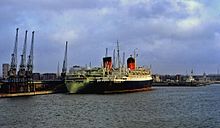 The Caronia and Carinthia laid up in Southampton.
The Caronia and Carinthia laid up in Southampton.
Within ten years of the introduction of jet airliners in 1958, most of the conventional Atlantic liners were gone. Mauretania was retired in 1965, the Queen Mary and Caronia in 1967, and the Queen Elizabeth in 1968. Two of the new intermediate liners were sold by 1970 and the other two were converted to cruise ships.[2] Cunard tried operating scheduled air services to North America, the Caribbean and South America by forming BOAC-Cunard Ltd in 1962 with the British Overseas Airways Corporation, but this venture lasted only until 1966.[23]
Trafalgar House Years
By 1971, when the line was purchased by the conglomerate Trafalgar House, Cunard operated cargo and passenger ships, hotels and resorts. Its cargo fleet consisted of 42 ships in service, with 20 on order. The flagship of the passenger fleet was the two-year-old Queen Elizabeth 2. The fleet also included the remaining two intermediate liners from the 1950s, plus two purpose-built cruise ships on order. Trafalgar acquired two additional cruise ships and disposed of the intermediate liners and most of the cargo fleet.[24] During the Falklands War, the QE2 and the Cunard Countess were chartered as troopships[25] while Cunard's container ship Atlantic Conveyor was sunk by an Exocet missile.[26]
 Queen Elizabeth 2 of 1969 (70,300 GRT), at Trondheim, Norway, in 2006.
Queen Elizabeth 2 of 1969 (70,300 GRT), at Trondheim, Norway, in 2006.
Cunard acquired the Norwegian America Line in 1983, with two classic ocean liner/cruise ships.[27] Also in 1983, the Trafalgar attempted a hostile takeover of P&O, another large passenger and cargo shipping line, which was formed the same year as Cunard. P&O objected and forced the issue to the British Monopolies and Mergers Commission. In their filing, P&O was critical of Trafalgar's management of Cunard and their failure to correct QE2's mechanical problems.[28] In 1984, the Commission ruled in favor of the merger, but Trafalgar decided against proceeding.[29] In 1988, Cunard acquired Ellerman Lines and its small fleet of cargo vessels, organizing the business as Cunard-Ellerman, however, only a few years later, Cunard decided to abandon the cargo business and focus solely on cruise ships. Cunard's cargo fleet was sold off between 1989 and 1991, with a single container ship, the second Atlantic Conveyor, remaining under Cunard ownership until 1996. In 1994 Cunard purchased the rights to the name of the Royal Viking Line and its Royal Viking Sun. The rest of Royal Viking Line's fleet stayed with the line's owner, Norwegian Cruise Line.[30]
By the mid 1990s Cunard was ailing. The company was embarrassed in late 1994 when the QE2 experienced numerous defects during the first voyage of the season because of unfinished renovation work. Claims from passengers cost the company US$13 million. After Cunard reported a US$25 million loss in 1995, Trafalgar assigned a new CEO to the line, who concluded that the company had management issues. In 1996 the Norwegian conglomerate Kværner acquired Trafalgar House, and attempted to sell Cunard. When there were no takers, Kværner made substantial investments to turn around the company's tarnished reputation.[31]
Carnival
Queen Victoria of 2007 (90,000 GT)
In 1998 Cunard was sold to the cruise line conglomerate Carnival Corporation for US$500 million.[32] The next year Carnival acquired the remaining stock for US$205 million.[33] Each of Carnival's cruise lines is positioned to appeal to a different market, and Carnival was interested in rebuilding Cunard as a luxury brand trading on its British traditions. Under the slogan "Advancing Civilization Since 1840," Cunard's advertising campaign sought to emphasize the elegance and mystique of ocean travel.[34] Only the QE2 and Caronia continued under the Cunard brand and the company started Project Queen Mary to build a new ocean liner/cruise ship for the transatlantic route.[35]
By 2001 Carnival was the largest cruise company, followed by Royal Caribbean and P&O Princess, which had recently demerged from its parent P&O. When Royal Caribbean and P&O Princess agreed to merge, Carnival countered with a hostile takeover bid for P&O Princess. Carnival rejected the idea of selling Cunard to resolve antitrust issues with the acquisition.[36] European and U.S. regulators approved the merger without requiring Cunard's sale.[37] After the merger was completed, Carnival moved Cunard's headquarters to the offices of Princess Cruises in Santa Clarita, California so that administrative, financial and technology services could be combined.[38]
With the opening of Carnival House in Southampton in 2009,[39] executive control of Cunard Line was subsequently transferred from Carnival Corporation in the United States, to Carnival UK, the primary operating company of Carnival plc. As the UK listed holding company of the group, Carnival plc now has executive control of all Carnival Group activities in the UK, with all UK based brands, including Cunard, being headquartered in offices at Carnival House.
In 2004, the 36-year-old QE2 was replaced on the North Atlantic by Queen Mary 2. Caronia was sold and QE2 continued to cruise until she was retired in 2008. In 2007 Cunard added a large cruise ship, Queen Victoria. She is not a sister for the QM2, being ordered by Carnival as a Vista class cruise ship for the Holland America Line. To reinforce Cunard traditions, the QV has a small museum on board. Cunard commissioned a second Vista class cruise ship, Queen Elizabeth in 2010.[40]
On December 1, 2011 the QM2 will change vessel registry to Hamilton, Bermuda.[41] This marks the first time in the 171-year history of the company that it will have no ships registered within the United Kingdom.[42]
- The Halifax Maritime Museum of the Atlantic has a special display on the Cunard Line and a statute of Samuel Cunard is at the nearby waterfront.[43]
Fleet
The Cunard fleet, all built for Cunard unless otherwise indicated, consisted of the following ships in order of acquisition:[1]
1840–1865
Ship Built In service for Cunard Type Tonnage Notes Unicorn 1836 1840–1846 wood-paddler 650 GRT coastal steamer purchased for Montreal service, sold 1846 Britannia 1840 1840–1849 wood-paddler 1,150 GRT Eastbound record holder, sold to North German Navy 1849 Acadia 1840 1840–1849 wood-paddler 1,150 GRT sold to North German Navy 1849 Caledonia 1840 1840–1850 wood-paddler 1,150 GRT sold to Spanish Navy 1850 Columbia 1841 1841–1843 wood-paddler 1,150 GRT Blue Riband, wrecked 1843 without loss of life Hibernia 1843 1843–1850 wood-paddler 1,400 GRT Eastbound record holder, sold to Spanish Navy 1850 Cambria 1845 1845–1860 wood-paddler 1,400 GRT Blue Riband, sold to Italian owners 1860 America 1848 1848–1863 wood-paddler 1,850 GRT Blue Riband, sold 1863 and converted to sail Niagara 1848 1848–1866 wood-paddler 1,850 GRT sold 1866 and converted to sail Europa 1848 1848–1867 wood-paddler 1,850 GRT Blue Riband, sold 1867 Canada 1848 1848–1866 wood-paddler 1,850 GRT Eastbound record holder, sold 1866 and converted to sail Asia 1850 1850–1868 wood-paddler 2,250 GRT Blue Riband, sold 1868 Africa 1850 1850–1868 wood-paddler 2,250 GRT sold 1868 Arabia 1852 1852–1864 wood-paddler 2,400 GRT sold 1864 and converted to sail Andes 1852 1852–1859 iron-screw 1,400 GRT sold to Spanish Government 1859 Alps 1853 1853–1859 iron-screw 1,400 GRT sold to Spanish Government 1859 Jura 1854 1854–1860 iron-screw 2,200 GRT sold to Allan Line 1860 Etna 1855 1855–1860 iron-screw 2,200 GRT sold to Inman Line 1860 Persia 1856 1856–1869 iron-paddler 3,300 GRT Blue Riband, taken out of service 1868 and scrapped 1872 Australian 1857 1860–1876 iron-screw 2,700 GRT built for other owners, sold 1876 China 1862 1862–1880 iron-screw 2,550 GRT sold to Spanish owners 1880 Scotia 1862 1864–1878 iron-paddler 3,850 GRT Blue Riband, sold 1878 and converted to cable layer Cuba 1864 1865–1876 iron-screw 2,700 GRT sold 1876 and converted to sail Java 1865 1865–1879 iron-screw 2,700 GRT sold 1879 and converted to sail 1865–1897
Ship Built In service for Cunard Type Tonnage Notes Russia 1867 1867–1880 express 2,950 GRT sold to Red Star Line 1880 Siberia 1867 1867–1880 intermediate 2,550 GRT sold to Spanish owners 1880 Samaria 1868 1868–1892 intermediate 2,550 GRT sold 1892 Batavia 1870 1870–1884 intermediate 2,550 GRT traded in for Oregon 1884 Abyssinia 1870 1870–1880 express 3,250 GRT sold to Guion Line 1880 Algeria 1870 1870–1881 express 3,250 GRT sold to Red Star Line 1881 Parthia 1870 1870–1884 intermediate 3,150 GRT traded in for Oregon 1884, scrapped 1955 Bothnia 1874 1874–1898 express 4,550 GRT sold 1898 Scythia 1875 1875–1899 express 4,550 GRT sold 1899 Gallia 1879 1879–1897 express 4,800 GRT sold to Beaver Line 1899 Cathalonia 1881 1881–1901 intermediate 4,850 GRT sold 1901 Cephalonia 1882 1882–1900 intermediate 5,500 GRT sold to Russian Navy 1900, sunk Port Authur Pavonia 1882 1882–1900 intermediate 5,500 GRT sold 1900 Servia 1881 1881–1902 express 7,400 GRT first steel liner to New York, scrapped 1902 Aurania 1883 1883–1905 express 7,250 GRT sold 1905 Oregon 1883 1884–1886 express 7,400 GRT Blue Riband, built for Guion Line, purchased by Cunard 1884, sank 1886 without loss of life Umbria 1884 1884–1910 express 7,700 GRT Blue Riband, sold 1910 Etruria 1884 1884–1910 express 7,700 GRT Blue Riband, sold 1910 Campania 1893 1893–1914 express 12,900 GRT Blue Riband, sold to Royal Navy 1914 and converted to aircraft carrier Lucania 1893 1893–1909 express 12,900 GRT Blue Riband, scrapped after fire 1909 1897–1929
Ship Built In service for Cunard Type Tonnage Notes Ultonia 1899 1899–1917 intermediate 10,400 GRT sunk by submarine 1917 Ivernia 1900 1900–1917 intermediate 14,250 GRT sunk by submarine 1917 Saxonia 1900 1900–1925 intermediate 14,250 GRT sold 1925 Carpathia 1903 1903–1918 intermediate 13,600 GRT rescued survivors from Titanic, sunk by submarine 1918 Caronia 1905 1905–1932 intermediate 19,650 GRT scrapped 1932 Carmania 1905 1905–1932 intermediate 19,650 GRT scrapped 1932 Lusitania 1907 1907–1915 express 31,550 GRT Blue Riband, sunk by submarine 1915 Mauretania 1907 1907–1934 express 31,950 GRT Blue Riband, scrapped 1934 Franconia 1911 1911–1916 intermediate 18,100 GRT sunk by submarine 1916 Albania 1900 1911–1912 intermediate 7,650 GRT built for Thompson Line, purchased by Cunard 1911, sold 1912 Ascania 1911 1911–1918 intermediate 9,100 GRT wrecked 1918 Laconia 1912 1912–1917 intermediate 18,100 GRT sunk by submarine 1917 Andania 1913 1913–1918 intermediate 13,400 GRT sunk by submarine 1918 Alaunia 1913 1913–1916 intermediate 13,400 GRT sunk by mine 1916 Aquitania 1914 1914–1950 express 45,650 GRT scrapped 1950 Orduna 1914 1914–1921 intermediate 15,700 GRT built for other owners, acquired by Cunard 1914, sold 1921 Aurania 1916 1916–1918 intermediate 13,400 GRT sunk by submarine 1918 Albania 1920 1920–1930 intermediate 12,750 GRT sold to Libera Triestina 1930 Berengaria 1913 1921–1938 express 51,950 GRT built by Hapag as Imperator, purchased by Cunard 1921, sold for scrap 1938 Scythia 1921 1921–1958 intermediate 19,700 GRT scrapped 1958 Samaria 1922 1922–1955 intermediate 19,700 GRT scrapped 1955 Laconia 1922 1922–1942 intermediate 19,700 GRT sunk by submarine 1942 Antonia 1922 1922–1942 intermediate 13,900 GRT sold to Admiralty 1942 Austonia 1922 1922–1942 intermediate 13,900 GRT sold to Admiralty 1942 Lancastria 1922 1922–1940 intermediate 16,250 GRT sunk by bombing 1940 Franconia 1923 1923–1956 intermediate 20,200 GRT scrapped 1956 Aurania 1924 1924–1942 intermediate 14,000 GRT sold to Admiralty 1942 Carinthia 1925 1925–1940 cruise 20,200 GRT sunk by submarine 1940 Ascania 1925 1925–1956 intermediate 14,000 GRT scrapped 1956 Alaunia 1925 1925–1942 intermediate 14,000 GRT sold to Admiralty 1942 1929–present
See also: White Star Line's Olympic, Homeric, Majestic, Doric, Laurentic, Britannic and Georgic
Ship Built In service for Cunard Type Tonnage Notes Queen Mary 1936 1936–1967 express 80,750 GRT Blue Riband, sold 1967, now a docked hotel ship Mauretania 1939 1939–1965 express 37,750 GRT scrapped 1965 Queen Elizabeth 1940 1946–1968 express 83,650 GRT WWII troopship 1940-1945, sold 1968, destroyed by fire 1972 Media 1947 1947–1961 cargo liner 13,350 GRT sold to Cogedar Line 1961 Parthia 1947 1947–1961 cargo liner 13,350 GRT sold to P&O 1961 Caronia 1949 1949–1968 cruise 34,200 GRT sold 1968, wrecked 1974 Saxonia
Carmania1954 1954-1962
1962-1973intermediate
cruise21,637 GRT
21,370 GRTSold to the Black Sea Shipping Company, Soviet Union 1973 Ivernia
Franconia1955 1955-1963
1963-1973intermediate
cruise21,800 GRT Sold to the Far Eastern Shipping Company, Soviet Union 1973 Carinthia 1956 1956–1968 intermediate 21,800 GRT sold to Sitmar Line 1968 Sylvania 1957 1957–1968 intermediate 21,800 GRT sold to Sitmar Line 1968 Queen Elizabeth 2 1969 1969–2008 express 70,300 GRT sold 2008, laid up in Port Rashid Cunard Adventurer 1971 1971–1977 cruise 14,150 GRT sold to Norwegian Cruise Line 1977 Cunard Ambassador 1972 1972–1974 cruise 14,150 GRT sold after fire 1974 to C. Clausen and converted to a cattle carrier Cunard Countess 1975 1976–1996 cruise 17,500 GRT sold to Awani Cruise Line 1996 Cunard Princess 1975 1977–1995 cruise 17,500 GRT sold to MSC Cruises 1995 Sagafjord 1965 1983–1997 cruise 24,500 GRT built for Norwegian America Line, sold to Saga Cruises 1997 Vistafjord
Caronia1973 1983-1999
1999-2004cruise 24,300 GRT built for Norwegian America Line, sold to Saga Cruises 2004 Sea Goddess I 1984 1986–1998 cruise 4,333 GRT Built for Sea Goddess Cruises, transferred to Seabourn Cruise Line 1998 Sea Goddess II 1985 1986–1998 cruise 4,333 GRT Built for Sea Goddess Cruises, transferred to Seabourn Cruise Line 1998 Royal Viking Sun 1988 1994–1999 cruise 37,850 GRT built for Royal Viking Line, transferred to Seabourn Cruise Line 1999 Queen Mary 2 2004 2004–present express 150,000 GT in service Queen Victoria 2007 2007–present cruise 90,000 GT in service Queen Elizabeth 2010 2010–present cruise 92,000 GT in service References
- ^ a b c d e f g h i j k l m n o p q r s t u v Gibbs, Charles Robert Vernon (1957). Passenger Liners of the Western Ocean: A Record of Atlantic Steam and Motor Passenger Vessels from 1838 to the Present Day. John De Graff. pp. 52–92.
- ^ a b c d e f g h i j k l Maxtone-Graham, John (1972). The Only Way To Cross. Collier.
- ^ Parry, Ann (1963). Parry of the Arctic. London.
- ^ Grant, Kay (1967). Samuel Cunard. London.
- ^ a b c d e Langley, John G. (2006). Steam Lion. Nimbus.
- ^ Beck, J. Murray (1984). Joseph Howe, Conservative Reformer. McGill-Queens.
- ^ a b c d UK CPI inflation numbers based on data available from Lawrence H. Officer (2010) "What Were the UK Earnings and Prices Then?" MeasuringWorth.
- ^ a b c Arnell, J.C, (1986). Steam and the North Atlantic Mails. Toronto.
- ^ a b c d e f g Fox, Stephen. Transatlantic: Samuel Cunard, Isambard Brunel and the Great Atlantic Steamships.
- ^ Body, Geoffey (1971). British Paddle Steamers. Newton Abbot.
- ^ a b c d Bacon, Edwin M. (1911). Manual of Ship Subsidies.
- ^ Corlett, Ewan (1975). The Iron Ship: the Story of Brunel's ss Great Britain. Conway.
- ^ a b c d e Fry, Henry (1896). The History of North Atlantic Steam Navigation with Some Account of Early Ships and Shipowners. London: Sampson, Low & Marston. OCLC 271397492.
- ^ Ships of the Cunard Line; Dorman, Frank E.; Adlard Coles Limited; 1955
- ^ The National Archives, BT107/202, Beaumaris 1830 No. 24, 132'2" x 20'6" x 12'8", 138 tons.
- ^ a b c d Kludas, Arnold (1999). Record breakers of the North Atlantic, Blue Riband Liners 1838-1953. London: Chatham.
- ^ Preble, George Henry; John Lipton Lochhead (1883). A Chronological History of the Origin and Development of Steam Navigation. Philadelphia: L.R. Hamersley. OCLC 2933332.
- ^ "Cunard History at a Glance". http://www.cunard.com/images/Content/History.pdf. Retrieved 2009-03-13.
- ^ "The Red Baron of Bearsden". Milngavie Herald. 14 December 2006. http://www.milngavieherald.co.uk/milngavie-yesterday/The-Red-Baron-of-Bearsden.1778877.jp. Retrieved 17 February 2010.
- ^ "75,000-Ton Vessel to Replace Queen Mary Is Urged in Britain". New York Times. 2 June 1960. http://select.nytimes.com/gst/abstract.html?res=F40B1EFA3D5C1A728DDDAB0894DE405B808AF1D3&scp=1&sq=75%2C000-ton+vessel+to+replace+Queen+Mary+is+urged+in+Britain&st=p.
- ^ "Queen Mary Plan Draws Protests". New York Times. 15 June 1961. http://select.nytimes.com/gst/abstract.html?res=FB0D16FC395D1B728DDDAC0994DE405B818AF1D3&scp=1&sq=queen%20mary%20plan%20draws%20protests&st=cse.
- ^ Horne, George (9 April 1963). "Cunard's Decision on New Liner Is Due by Board Meeting in June". New York Times. http://select.nytimes.com/gst/abstract.html?res=FB0710FA3858137A93CBA9178FD85F478685F9&scp=1&sq=Cunard%27s%20decision%20on%20new%20liner&st=cse.
- ^ Blair, Granger (16 September 1964). "BOAC buys out Cunard's Share". New York Times. http://select.nytimes.com/gst/abstract.html?res=FB0B16FF3C58117B93C4A81782D85F428685F9&scp=1&sq=boac+buys+out+cunard%27s+share&st=p.
- ^ Monopolies and Mergers Commission (1984). "Appendix 3: Trafalgar House PLC: composition of fleet in 1971 and 1983". Trafalgar House PLC & Peninsular and Oriental Steam Navigation Company: A report on the proposed merger. pp. 77–79. http://www.competition-commission.org.uk/rep_pub/reports/1984/fulltext/178appendices.pdf.
- ^ "A Full Log of Sailings". New York Times. 21 November 1982. http://www.nytimes.com/1982/11/21/travel/a-full-log-of-sailings.html?scp=1&sq=a%20full%20log%20of%20sailings&st=cse.
- ^ "French Missiles En Route to Argentina". New York Times. 19 November 1982. http://www.nytimes.com/1982/11/19/world/around-the-world-french-missiles-en-route-to-argentina.html?scp=1&sq=french%20missiles%20en%20route%20to%20argentina&st=cse.
- ^ "Cunard Purchase". New York Times. 12 May 1983. http://www.nytimes.com/1983/05/12/business/cunard-purchase.html?scp=1&sq=cunard%20purchase&st=cse.
- ^ Monopolies and Mergers Commission (1984). Trafalgar House PLC & Peninsular and Oriental Steam Navigation Company: A report on the proposed merger. http://www.competition-commission.org.uk/rep_pub/reports/1984/178traf_house_plc_peni_ori_steam_navigation_comp.htm.
- ^ "Trafalgar bid for P&O". New York Times. 15 March 1984. http://www.nytimes.com/1984/03/15/business/trafalgar-bid-for-p-o.html?scp=1&sq=trafalgar+bid+for+p%26o&st=nyt.
- ^ McDowell, Edwin (19 October 1994). "Cruise lines sail through choppy seas". New York Times. http://www.nytimes.com/1994/10/09/travel/fall-and-winter-cruises-cruise-lines-sail-through-choppy-seas.html?scp=1&sq=cruise%20lines%20sail%20through%20choppy%20seas&st=cse.
- ^ McDowell, Edwin (6 August 1996). "Chief's Strategy for an Ailing Cruise Line". New York Times. http://www.nytimes.com/1996/08/06/business/chief-s-strategy-for-an-ailing-cruse-line.html?scp=1&sq=chief%27s%20strategy%20for%20an%20ailing%20cruise%20line&st=cse.
- ^ "Carnival in $500 million deal to buy Cunard". New York Times. 4 April 1998. http://www.nytimes.com/1998/04/04/business/company-news-carnival-in-500-million-deal-to-buy-cunard.html?pagewanted=1.
- ^ "Carnival to buy remaining share in Cunard". New York Times. 20 October 1999. http://www.nytimes.com/1999/10/20/business/company-news-carnival-to-buy-remaining-stake-in-cunard-line.html?pagewanted=1.
- ^ McDowell, Edwin (19 August 1999). "Carnival's Cunard cruise line plans to spend 12.5 million to stress a touch of class". New York Times. http://www.nytimes.com/1999/08/19/business/media-business-advertising-carnival-s-cunard-cruise-line-plans-spend-12.5.html?pagewanted=1.
- ^ Wakin, Daniel (19 August 2001). "Restoring the Queen's Glamour". New York Times. http://www.nytimes.com/2001/08/19/business/private-sector-restoring-the-queens-glamour.html?scp=1&sq=restoring%20the%20queen%27s%20glamour&st=cse.
- ^ "Carnival may sell unit to complete takeover". New York Times. 28 May 2002. http://www.nytimes.com/2002/05/28/business/carnival-may-sell-unit-to-complete-takeover.html?pagewanted=1.
- ^ Kapner, Suzanne (25 October 2002). "End is seen in long battle for cruise line". New York Times. http://www.nytimes.com/2002/10/25/business/end-is-seen-to-long-battle-for-cruise-line.html?scp=2&sq=end%20is%20near%20in%20long%20battle%20for%20cruise%20line&st=cse.
- ^ "Carnival to move Cunard line's operations to California". New York Times. 12 July 2004. http://www.nytimes.com/2004/07/17/business/company-news-carnival-to-move-cunard-line-s-operations-to-california.html?pagewanted=1.
- ^ Keith Hamilton (20 july 2009). "Carnival UK moves into new Southampton headquarters". http://www.dailyecho.co.uk/news/4501646.Opening_of_landmark_city_base_for_Carnival_UK/. Retrieved 27 August 2010.
- ^ Santos, Fernanda (4 January 2008). "Three Seafaring Queens Spend a Day in New York". New York Times.
- ^ http://www.royalgazette.com/article/20111021/NEWS/710219930
- ^ http://www.guardian.co.uk/business/2011/oct/28/cunard-leaves-britain-bermuda
- ^ "Maritime Museum of the Atlantic". http://museum.gov.ns.ca/mma/index.html. Retrieved 2009-03-14.
External links
- Official website
- Cunard Fleet Listing
- Cunard Line Passenger Lists, Brochures, Other Historical Documents 1800s - 1954
- The Last Ocean Liners - Cunard Line - trade routes and ships of the Cunard Line since the 1950s
Cruise Lines of the Carnival Corporation & PLC Carnival Corporation 
Carnival UK Costa Cruises Group Categories:- Carnival Corporation & PLC
- Cunard Line
- Companies established in 1838
- Cruise lines
- History of Liverpool
- Packet (sea transport)
- Shipping companies of the United Kingdom
- Transatlantic shipping companies
- Travel and holiday companies of the United Kingdom
- 1838 establishments in the United Kingdom
Wikimedia Foundation. 2010.


